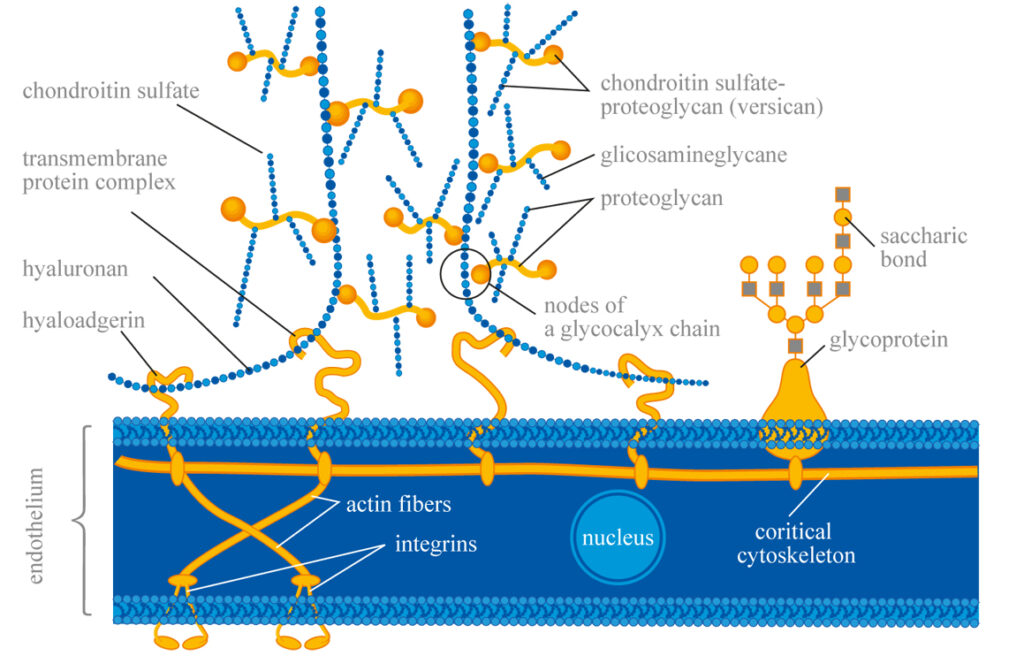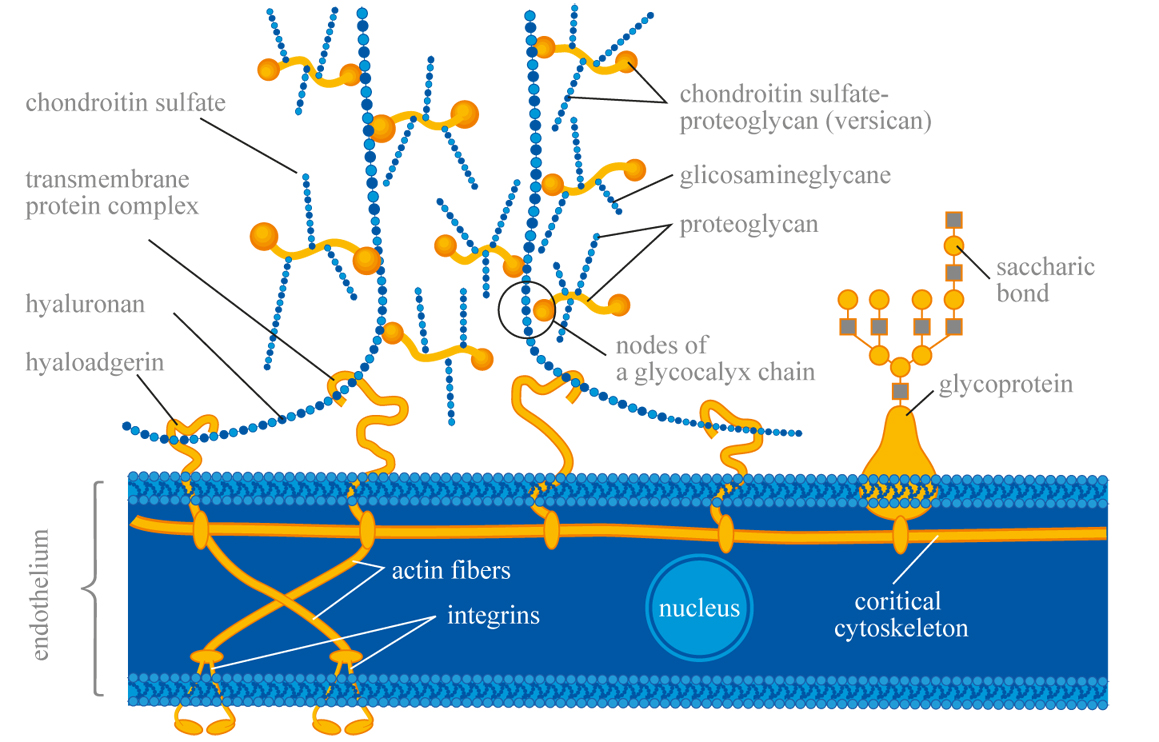
Glycocalyx: Unveiling the Sugar Coating of Cells and Its Vital Roles
The glycocalyx, often referred to as the “sugar coating” of cells, is a complex carbohydrate layer found on the outer surface of many cells, including bacteria, epithelial cells, and endothelial cells. This intricate structure plays a crucial role in various biological processes, from cell recognition and adhesion to protection against pathogens and regulation of vascular permeability. Understanding the glycocalyx is essential for comprehending cellular behavior and developing new therapeutic strategies. This article delves into the composition, functions, and clinical significance of the glycocalyx.
What is the Glycocalyx? A Deep Dive into its Composition
The glycocalyx isn’t a single, uniform structure but rather a diverse assembly of glycans – sugar molecules – attached to the outer cell membrane. These glycans can be linked to lipids, forming glycolipids, or to proteins, forming glycoproteins. The primary components include:
- Glycoproteins: Proteins with one or more oligosaccharide chains (glycans) covalently attached. These are often involved in cell signaling and cell-cell interactions.
- Glycolipids: Lipids with one or more oligosaccharide chains covalently attached. They contribute to membrane stability and cell recognition.
- Proteoglycans: Proteins with one or more glycosaminoglycan (GAG) chains attached. GAGs are long, linear polysaccharides that are highly negatively charged and attract water, contributing to the hydration and thickness of the glycocalyx. Examples include heparan sulfate, chondroitin sulfate, and hyaluronic acid.
The specific composition of the glycocalyx varies depending on the cell type, tissue, and even the physiological state of the organism. This variability allows for specialized functions in different contexts.
The Multifaceted Functions of the Glycocalyx
The glycocalyx performs a wide array of functions, contributing significantly to cellular health and overall organismal physiology:
Cell Recognition and Adhesion
The glycans within the glycocalyx act as recognition molecules, allowing cells to interact with each other and with the extracellular matrix. These interactions are crucial for tissue development, immune responses, and wound healing. For example, selectins, a family of cell adhesion molecules, bind to specific carbohydrate ligands on the glycocalyx, facilitating leukocyte rolling along the endothelium during inflammation.
Protection Against Pathogens
The glycocalyx forms a physical barrier that protects cells from mechanical stress, dehydration, and the adhesion of pathogens. The negatively charged GAGs within the glycocalyx can repel negatively charged bacteria and viruses, preventing infection. Some pathogens have evolved mechanisms to overcome this barrier, such as producing enzymes that degrade the glycocalyx.
Regulation of Vascular Permeability
In the endothelium, the glycocalyx plays a critical role in regulating vascular permeability, controlling the passage of fluids and molecules across the blood vessel wall. The glycocalyx acts as a molecular sieve, preventing the leakage of albumin and other plasma proteins into the surrounding tissues. Damage to the endothelial glycocalyx, often caused by inflammation or oxidative stress, can lead to increased vascular permeability and edema.
Mechanotransduction
The glycocalyx can act as a mechanosensor, transducing mechanical forces into intracellular signals. When cells are subjected to shear stress or compression, the glycocalyx deforms, triggering signaling pathways that regulate cell behavior. This is particularly important in endothelial cells, where the glycocalyx senses blood flow and regulates vascular tone.
Cell Signaling
Specific components of the glycocalyx can act as ligands for cell surface receptors, initiating signaling cascades that regulate cell growth, differentiation, and apoptosis. For example, heparan sulfate proteoglycans can bind to growth factors, modulating their activity and influencing cell proliferation.
The Glycocalyx in Health and Disease: Clinical Significance
The integrity and function of the glycocalyx are essential for maintaining health, and its disruption is implicated in various diseases:
Sepsis
Sepsis, a life-threatening condition caused by a dysregulated immune response to infection, is often associated with significant shedding of the endothelial glycocalyx. This shedding contributes to increased vascular permeability, edema, and organ dysfunction. Restoring the glycocalyx has emerged as a potential therapeutic strategy for sepsis.
Diabetes
Hyperglycemia in diabetes can damage the endothelial glycocalyx, leading to increased vascular permeability and microvascular complications such as retinopathy, nephropathy, and neuropathy. Strategies to protect and restore the glycocalyx may help prevent or delay these complications.
Atherosclerosis
Damage to the endothelial glycocalyx is an early event in the development of atherosclerosis, a disease characterized by the buildup of plaque in the arteries. The glycocalyx normally protects the endothelium from injury and inflammation, but its disruption allows for the adhesion of leukocytes and the accumulation of lipids, contributing to plaque formation.
Ischemia-Reperfusion Injury
Ischemia-reperfusion injury, which occurs when blood flow is restored to an organ after a period of ischemia (lack of blood flow), is associated with significant shedding of the endothelial glycocalyx. This shedding contributes to inflammation and tissue damage. Protecting the glycocalyx during ischemia-reperfusion may help reduce injury.
Cancer
The glycocalyx plays a complex role in cancer development and metastasis. In some cases, the glycocalyx can promote tumor growth and invasion by facilitating cell adhesion and signaling. In other cases, the glycocalyx can inhibit tumor growth by preventing cell adhesion and promoting immune recognition. The specific role of the glycocalyx in cancer depends on the type of cancer and the specific glycans involved.
Therapeutic Strategies Targeting the Glycocalyx
Given the importance of the glycocalyx in health and disease, there is growing interest in developing therapeutic strategies that target this structure. These strategies include:
- Glycocalyx-protective agents: These agents aim to prevent the shedding or degradation of the glycocalyx. Examples include antioxidants, anti-inflammatory drugs, and specific GAGs.
- Glycocalyx-restoring agents: These agents aim to promote the synthesis and assembly of the glycocalyx. Examples include precursors for GAG synthesis and enzymes that modify glycans.
- Glycan-targeted therapies: These therapies target specific glycans on the glycocalyx to modulate cell behavior or deliver drugs. Examples include antibodies that bind to specific glycans and nanoparticles coated with glycans.
Research in this area is ongoing, and these therapies hold promise for treating a variety of diseases.
Future Directions in Glycocalyx Research
Our understanding of the glycocalyx is rapidly evolving, and future research will likely focus on:
- Developing more sophisticated tools to visualize and characterize the glycocalyx. This will allow for a better understanding of its structure and function in different contexts.
- Identifying the specific glycans that are involved in different diseases. This will allow for the development of more targeted therapies.
- Evaluating the efficacy of glycocalyx-targeted therapies in clinical trials. This will determine whether these therapies are safe and effective for treating human diseases.
The glycocalyx is a dynamic and complex structure that plays a vital role in cellular health and overall organismal physiology. Further research into this fascinating area will undoubtedly lead to new insights into disease mechanisms and the development of novel therapeutic strategies. The glycocalyx presents a promising avenue for future medical advancements. [See also: Endothelial Glycocalyx and Vascular Health] The importance of maintaining a healthy glycocalyx cannot be overstated. The glycocalyx’s role in cell signaling is also a key area of ongoing investigation. The glycocalyx is truly a remarkable structure.

